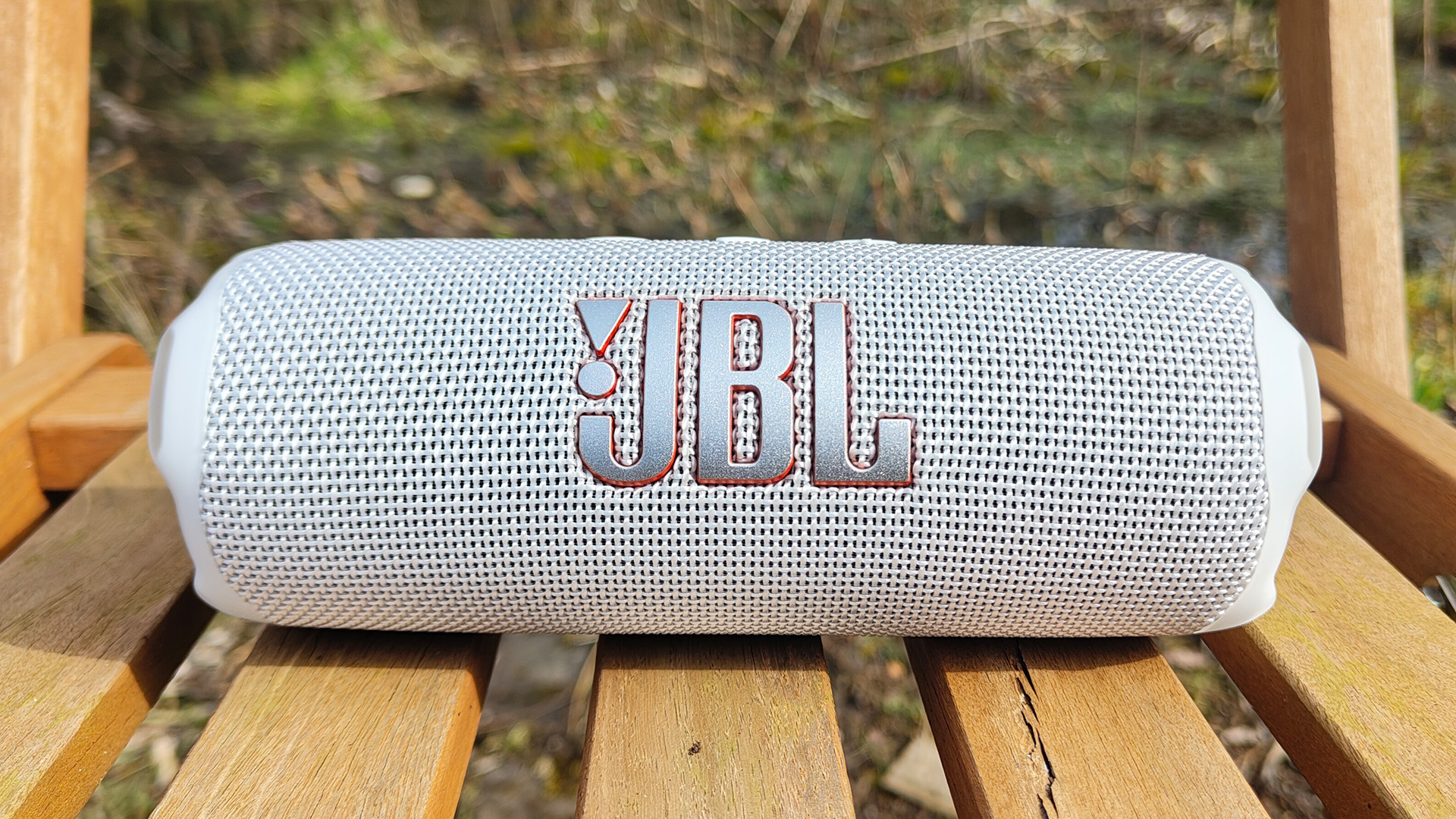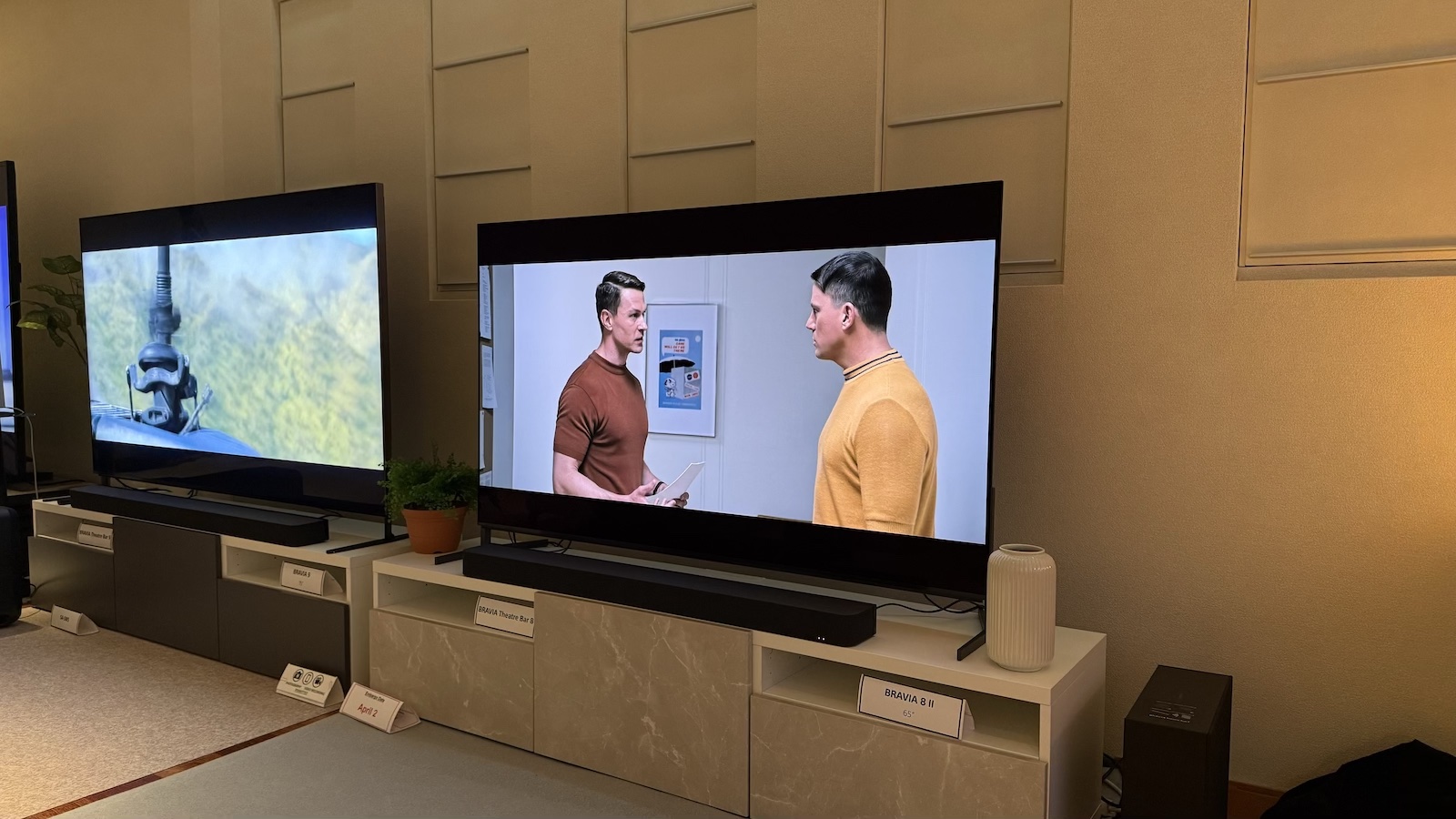What Hi-Fi? Verdict
Hearty improvements to build quality, features and usability make the Flip 7 a more rounded performer than ever before, while sonic advances see it stride well clear of the competition
Pros
- +
Adds new levels of clarity and insight than previous generations
- +
Skilful handling of dynamics and rhythms
- +
Excellent build quality
- +
Strong feature set includes Auracast and lossless wired audio
Cons
- -
Can't pair with older generations
- -
No supplied USB-C cable
Why you can trust What Hi-Fi?
There’s a character from the popular animated TV series Invincible so powerful that his most feared enemy is boredom itself. The clunkily named ‘Battle Beast’ is such a proficient warrior that he will often decline a scrap because it isn’t worthy of his prowess, shying away from a battle not because it’s too difficult, but because it isn’t difficult enough.
We wonder if that’s how JBL feels sometimes. In case you hadn’t noticed, the American brand has been king of the Bluetooth speaker hill in recent years and is in danger of monopolising the market, helping to redefine portable, affordable performance with its healthy roster of five-star and Award-winning products. It can be lonely at the top, after all.
The Charge 5, the Go 4, the Xtreme 4 and now the new JBL Flip 7 – can anyone step in to give the titan a worthwhile test? Given the performance and appeal of this latest-generation Flip, JBL might be waiting a while yet for a suitable challenger to its crown.
Price
The JBL Flip 7 has the same £130 UK launch price as the previous Flip 6, but for US users, the cost has risen from $130 to $150. Do bear in mind, of course, that the Flip 6 no longer sits at its original RRP, often dropping to as low as around £90 / $80 / AU$120 these days. In Australia, the Flip 7 will cost AU$170 when it's available in July.
What about current contemporary rivals at this level? The larger JBL Charge 5 – still available after being superseded by the new Charge 6 – usually sits at roughly £119 / $120 these days, whereas the similarly portable Beats Pill will set you back around £110 / $150 / AU$250.
Build & design
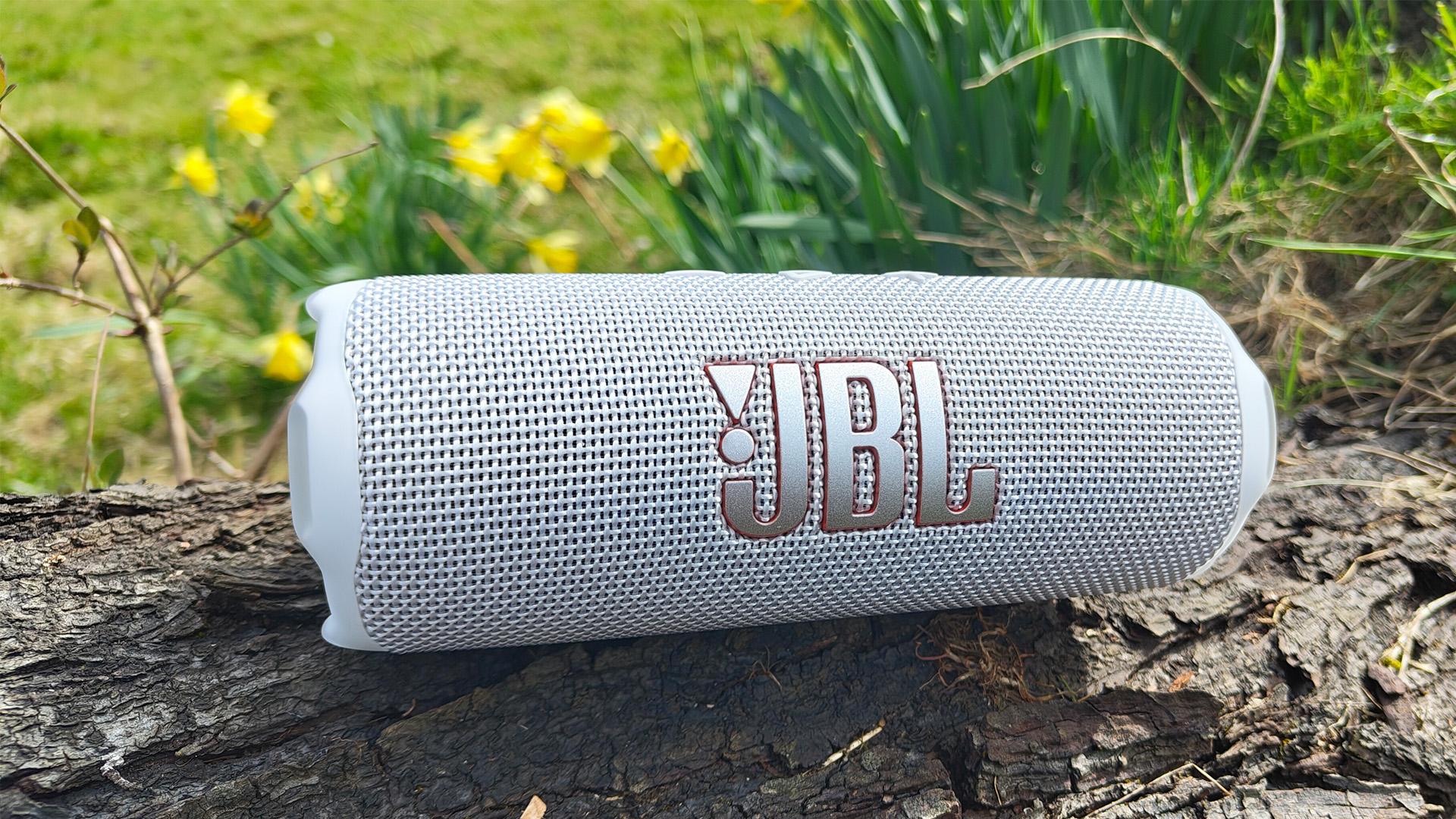
Externally, JBL hasn’t rewritten the rulebook for its seventh iteration of the popular Flip line, instead opting for a few welcome improvements to the speaker’s usability and portability credentials. The Flip 7’s size and aspect are much the same as the Flip 6, retaining that cylindrical ‘burrito’ shape that fits nicely in the hand and slots conveniently down the side of a backpack or travel bag. What’s that saying about if it ain’t broke?
Looks can be deceiving, so let’s not fall into the trap of thinking that just because the new Flip looks the same, it is the same. The older generation model boasted a still-impressive IP67 water and dustproof rating, but JBL has decided to up the ante by bestowing a mighty IP68 certificate upon this newest iteration. As far as water and dust are concerned, the latest Flip is a small, colourful Fort Knox – thrown around a sandy astroturf, sprayed with a hose or dunked in a bathtub, the Flip 7 isn’t bothered. “Is that all you got?” our test sample seems to say as we ready it for another soaking. Its drop-proof credentials have also increased, with the rubber guards at either end slightly more beefed up.
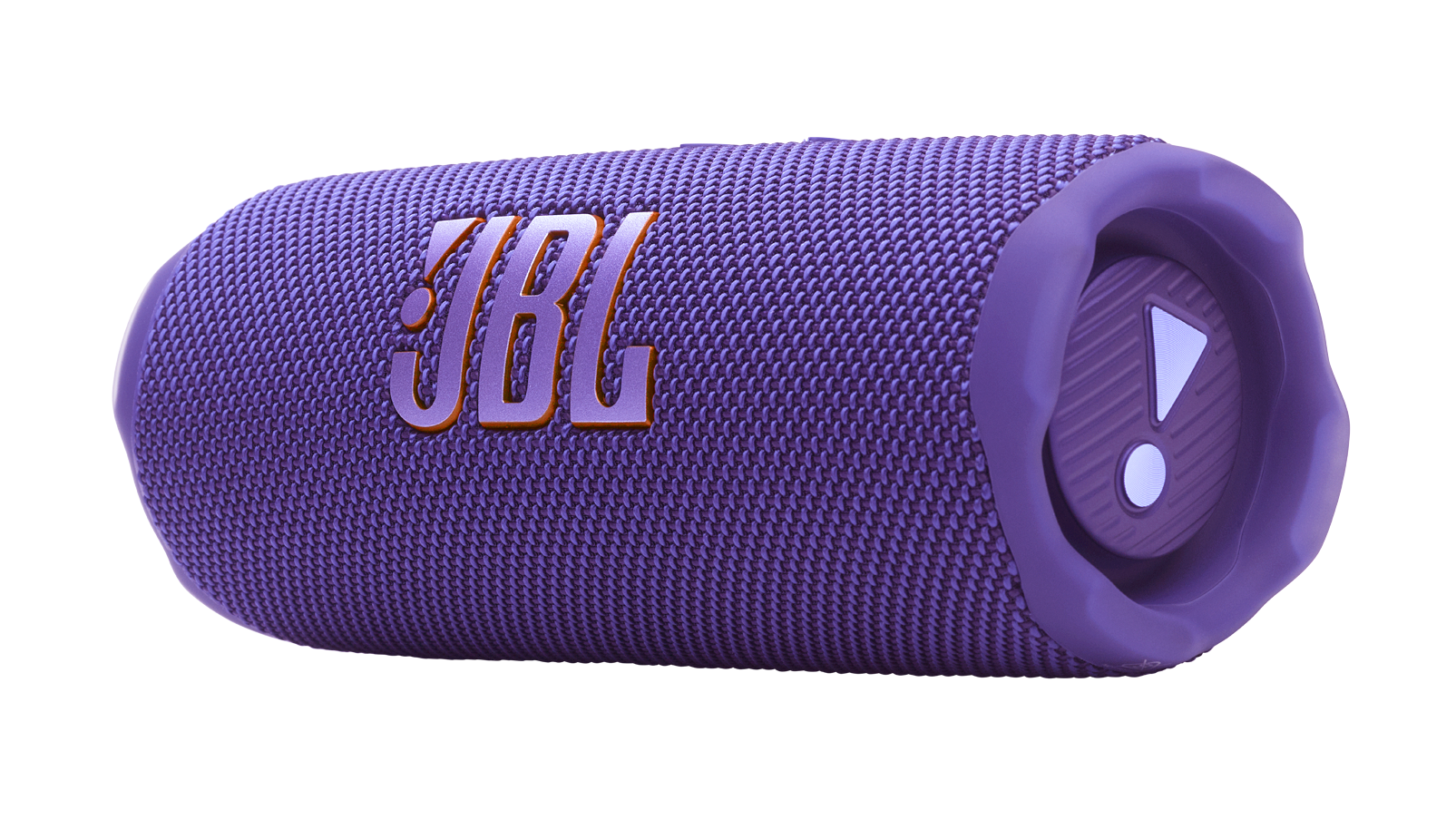
Power 35 Watts
Bluetooth 5.4
Mains-powered or battery-powered Battery-powered
Battery life 14 hours; 16 hours with Playtime Boost
Features Auracast audio sharing, IP68 rating, lossless audio via USB-C, AI Sound Boost, stereo pairing
Connections USB-C for wired audio and charging
Dimensions (hwd) 6.9 x 18.3 x 7.1cm
Weight 560g
Finishes x 7 (Blue, Black, Squad, Purple, White, Red, Pink)
While the Flip 6 had most of its control functions sitting all in one row, the Flip 7 breaks things up a bit to make it easier to see and access the various options – it’s not a big change, but it does make the new model slightly easier to navigate. Atop the unit sits the usual trio of volume down, play/pause and volume up buttons – all of which are responsive in use. Above those controls is a small rubber panel with its own triumvirate of commands: a Bluetooth button for pairing, a power button and a sort of paperclip-cum-triangle representing the Flip 7’s new Auracast capabilities.
The new JBL isn’t done there. Ditching the built-in adjustable carry loop of its predecessor, the Flip 7 now offers a choice of either a small fabric finger loop or a carabiner hook for clipping the speakers onto the likes of bags, branches or anything else sturdy enough to support its weight. Attaching or detaching these accessories is just like clicking in a seatbelt, only more satisfying – each attachment slots into a recessed port on the unit’s underside and can be popped out using an adjacent release button.
What about internal driver changes? The Flip 7 teases crisper, clearer high-frequency reproduction courtesy of its updated tweeter dome design. JBL also promises beefier bass than before thanks to greater power (25 watts over its predecessor’s 20 watts) driving the Flip 7’s woofer.
Features
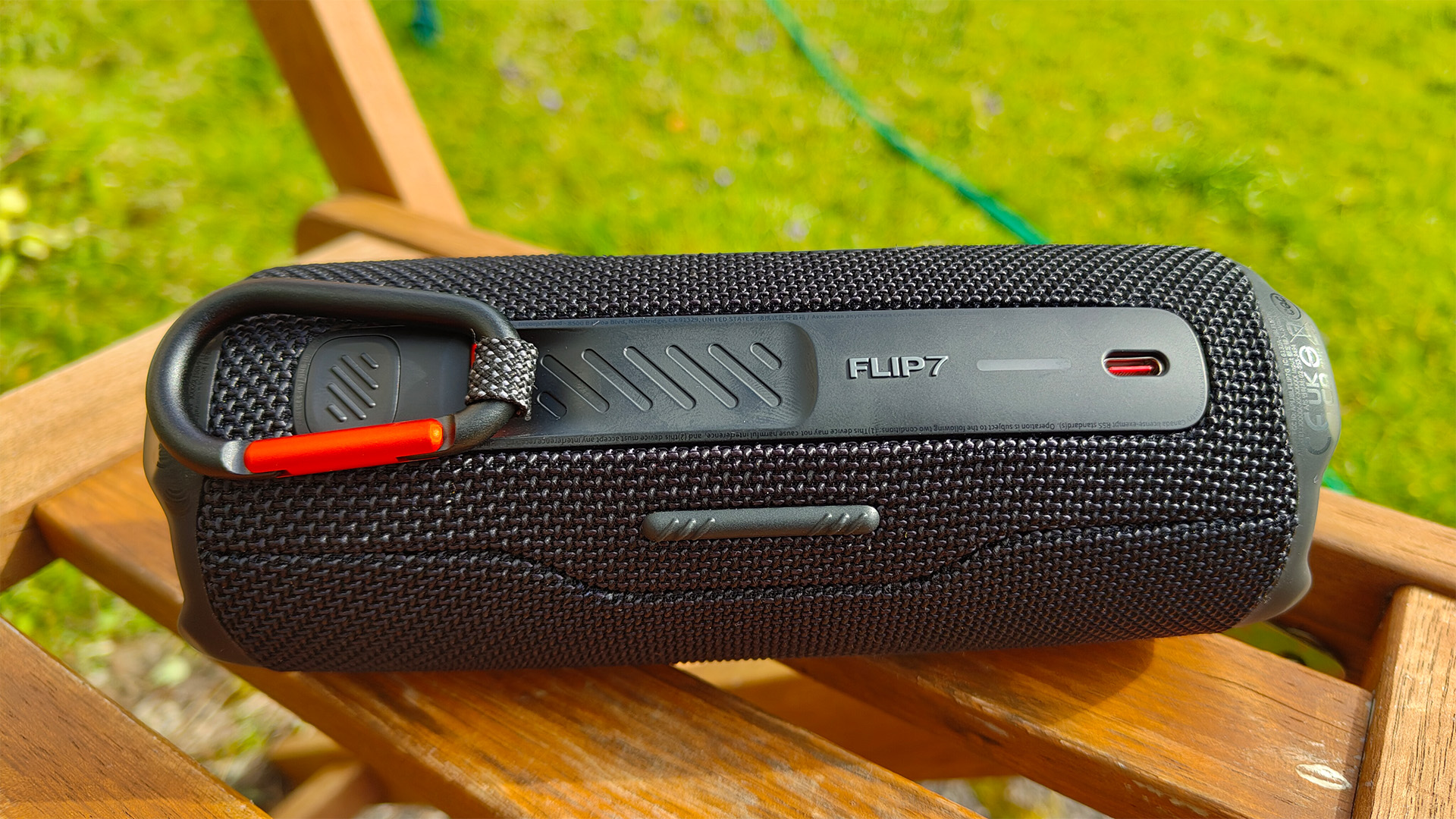
JBL has made a concerted effort to bring many of its more recent Bluetooth offerings up to par with its rivals when it comes to features, and the Flip 7 is no different. Like the current Go 4 and Xtreme 4, the seventh-gen Flip offers Auracast functionality, the new sharing technology which lets you pair two Flip 7s together in stereo or hook up multiple Auracast-compatible units in tandem via the JBL Portable app.
We used a Go 4 in conjunction with a couple of Flip 7s during our tests, but you can add a near-infinite number of recent JBL units together in party mode if you so choose, or hook up a couple of Flip 7s in stereo mode by assigning left and right channels via the app. It’s worth noting, however, that you can’t connect older models, such as the Flip 6, with a bunch of newer JBL speakers via Auracast, which is something of a downer for existing Flip owners.
JBL has bolstered the battery life of the Flip 7, at least on paper. The new speaker will furnish you with 14 hours on a single charge plus an extra two with Playtime Boost, a handy feature which extends your speaker’s battery life while dropping the amount of bass in the process. That’s four more than the older Flip 6 can manage when Playtime Boost is factored in, but unless you’re terrified you’re not going to have access to a plug socket for a whole day, we’d recommend keeping things playing in standard mode if you want your speaker to sound its best.
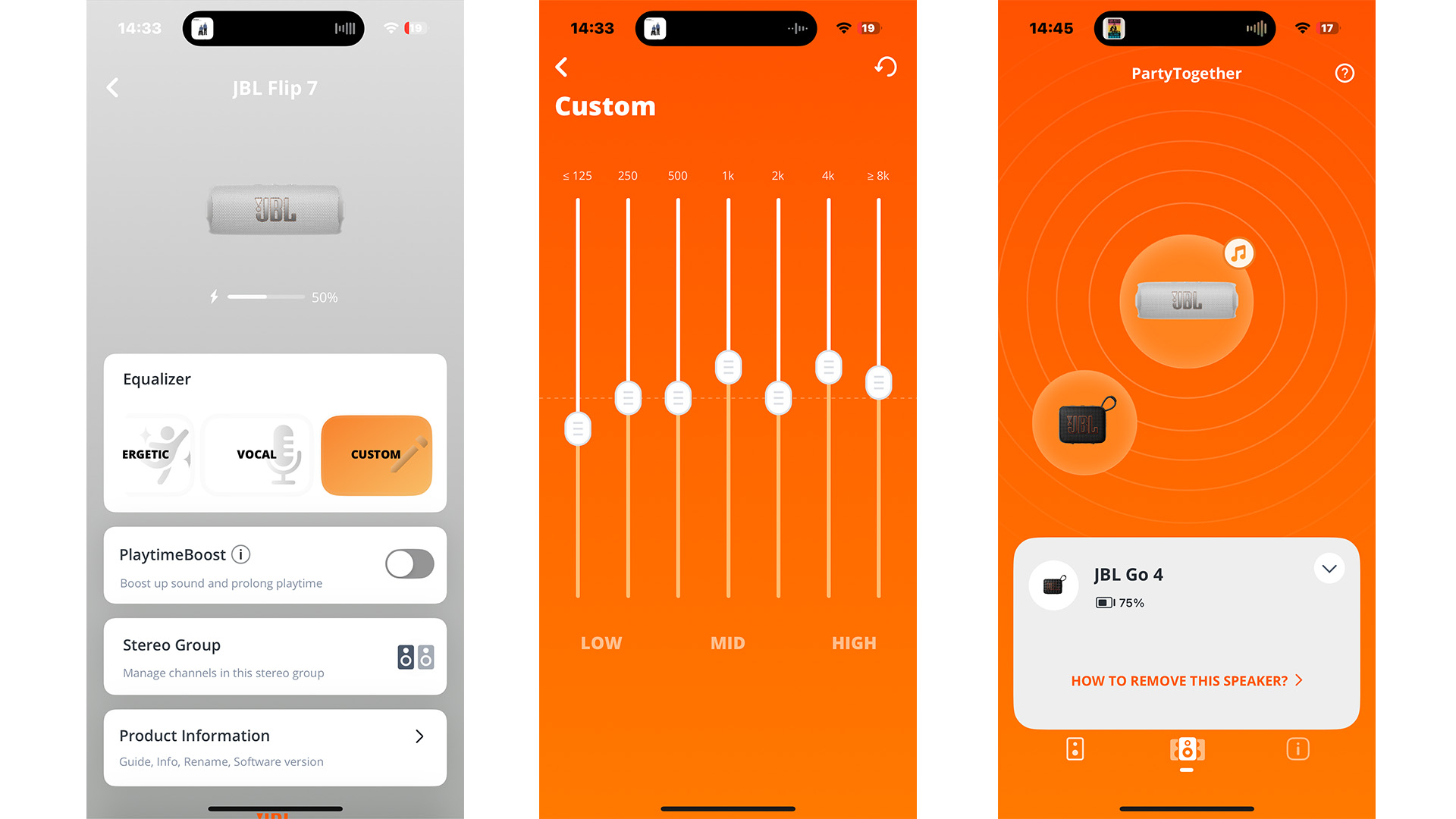
The Flip 7 makes use of JBL’s new 'AI Sound Boost', a proprietary technology that analyses soundwaves in real time to optimise the speaker's sonic output without distortion, resulting in a “bigger sound and deeper bass”. The Flip 7 also features wired listening for the first time, supporting up to 24-bit/96kHz lossless audio playback from music streaming services via USB-C, meaning that it should sound its absolute best when using a physical tether to your source. Don’t fear, it’s not a tricky process – make sure you’re holding down the speaker’s ‘play’ button as you plug in a USB-C cable and a cheerful tone will inform you that you’re now in wired playback mode.
We wish JBL had included a USB-C charging cable in the box, especially as it now supports wired audio mode, but any USB-C cable such as the one included with your smartphone will do just fine.
Sound
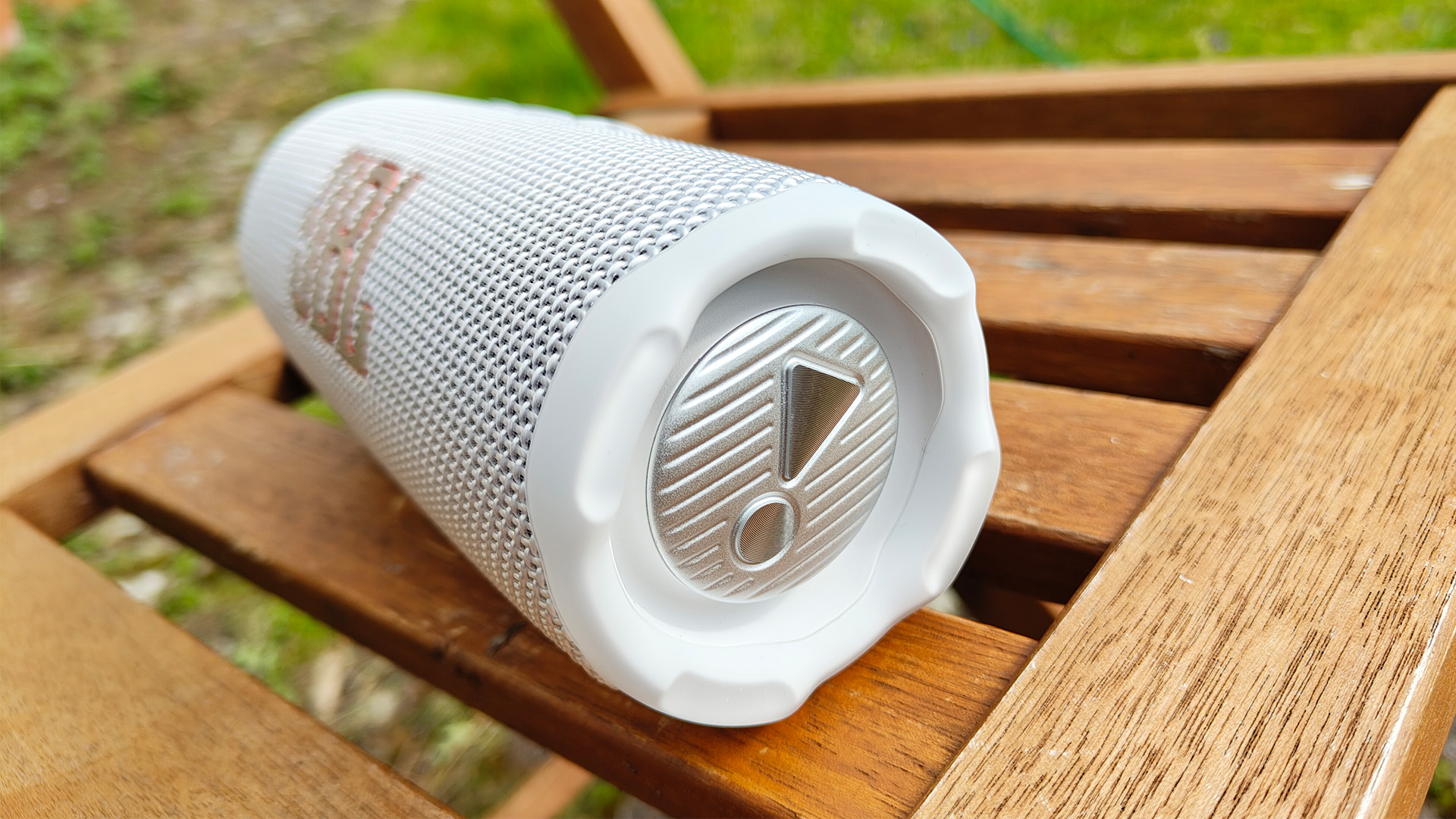
We’re going to give the game away early: this seventh-generation model is the best-sounding Flip there’s ever been. We use the outgoing Flip 6 as a reference point to assess the sonic improvements this latest model boasts, quickly discovering that strides have been made across the board to bolster the sonic credentials of 2025’s eager debutante.
Though the use of JBL’s AI-powered Sound Boost tech alongside that upgraded tweeter might sound a tad gimmicky, it’s hard to argue with how good the Flip 7 sounds as a result. This new addition to the line is a smoother, weightier and more robust-sounding performer than its predecessor, bringing so much heft and body to Muse’s Hysteria that it makes its sixth-generation ancestor seem almost malnourished by comparison.
The newer unit also brings far more bass to the party, once again making the outgoing Flip 6 come across as rather lacking when played side-by-side. The Charge 5 and newer Charge 6 will, naturally, take things a step further bass-wise, but for a unit of the Flip’s size, it’s hard to complain.
We know this is still a fairly compact portable Bluetooth speaker, but judged on such terms, the Flip 7 evidences what you might call genuine musicality. The subtleties of Jeff Buckley’s guitar playing on So Real are communicated with a deadly combination of accuracy and flair, complemented by bringing authenticity and clarity to dear old Jeff’s vocal stylings as he flits and flows from sultry whispers to his enthralling angelic wail.
Dynamically, this is quite possibly the best Flip we’ve ever heard, and those fluctuations on So Real stretch with more elasticity than on previous models – we notice the same skill as we switch over to Elliott Smith’s Ballad Of Big Nothing and discern the varying levels of force on each of the great man’s guitar strums. Rhythmic patterns are more effectively teased out, too, giving Nine Inch Nails’ Every Day Is Exactly The Same the thudding, march-like momentum it so sorely needs.
No matter the track, the Flip 7 is capable of putting you in the picture. Detail levels are strong for a unit of this size as instruments enjoy more bite and body this time around, with music benefitting from a layered, uncluttered soundscape that sounds composed and capable without losing out on a feeling of fun. Such qualities are only amplified by the addition of lossless audio via USB-C – digging out 24-bit tracks on Tidal reveals a more open, refined performance that benefits from even more precision and texture, not to mention punch and clarity, when listening via a physical connection.
Verdict
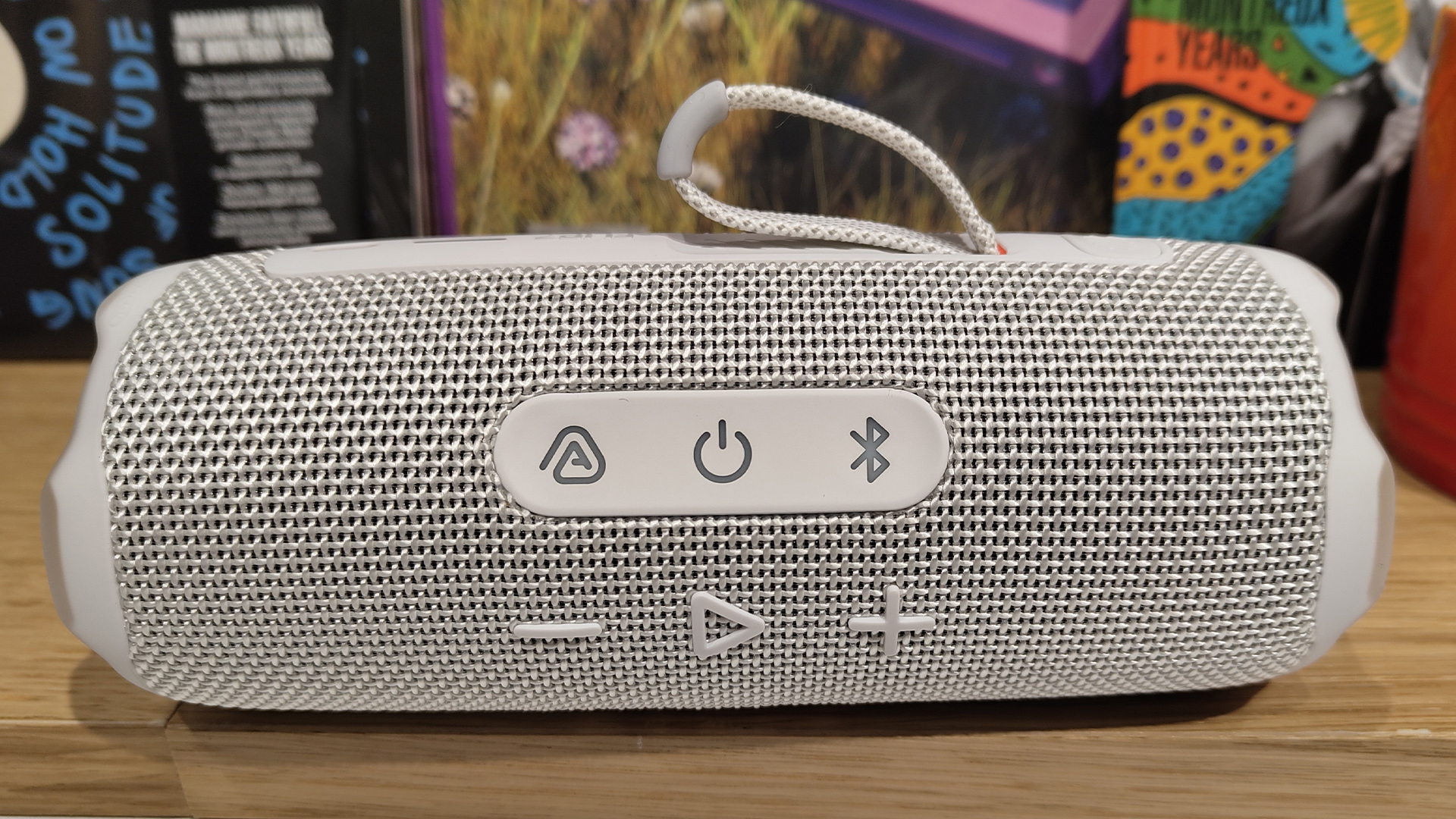
JBL has tweaked the Flip 7’s sound while adding a pleasing host of new features, performance benefits and improvements to its build and design, making for what now feels like the most well-rounded Flip ever. At this price, we can’t see much beating it – another great leap forward for JBL’s long-running series of burrito-shaped belters.
First reviewed: March 2025
SCORES
- Sound 5
- Build 5
- Features 5
MORE:
Read the Flip 6 review
JBL Flip 7 vs JBL Flip 6: which five-star Bluetooth speaker is better?
JBL Flip 7 vs JBL Charge 6: which Bluetooth speaker is best for you?
Best wireless speakers: tried and tested by our expert team

Harry McKerrell is a senior staff writer at What Hi-Fi?. During his time at the publication, he has written countless news stories alongside features, advice and reviews of products ranging from floorstanding speakers and music streamers to over-ear headphones, wireless earbuds and portable DACs. He has covered launches from hi-fi and consumer tech brands, and major industry events including IFA, High End Munich and, of course, the Bristol Hi-Fi Show. When not at work he can be found playing hockey, practising the piano or trying to pet strangers' dogs.
- Ketan BharadiaTechnical Editor
You must confirm your public display name before commenting
Please logout and then login again, you will then be prompted to enter your display name.
